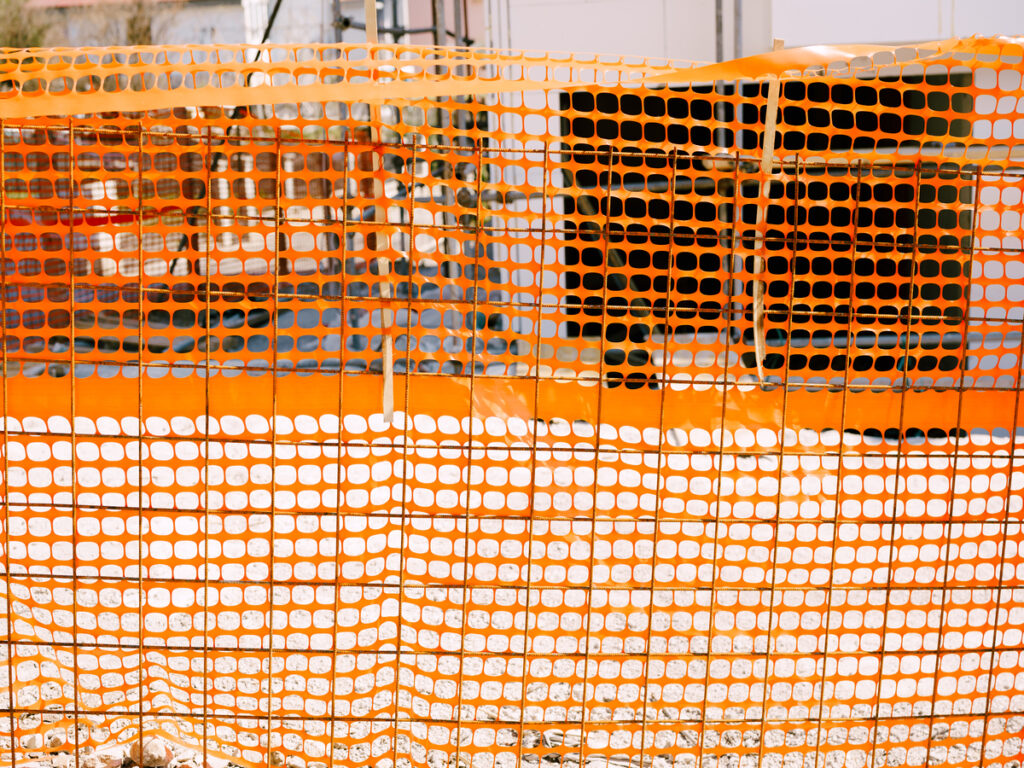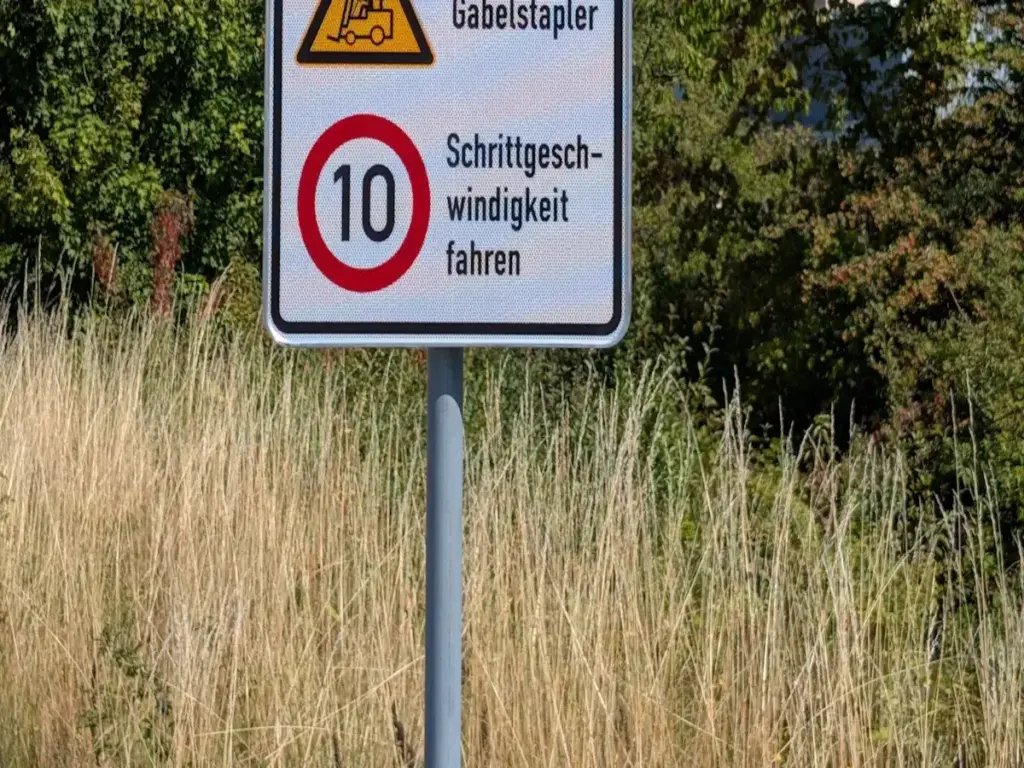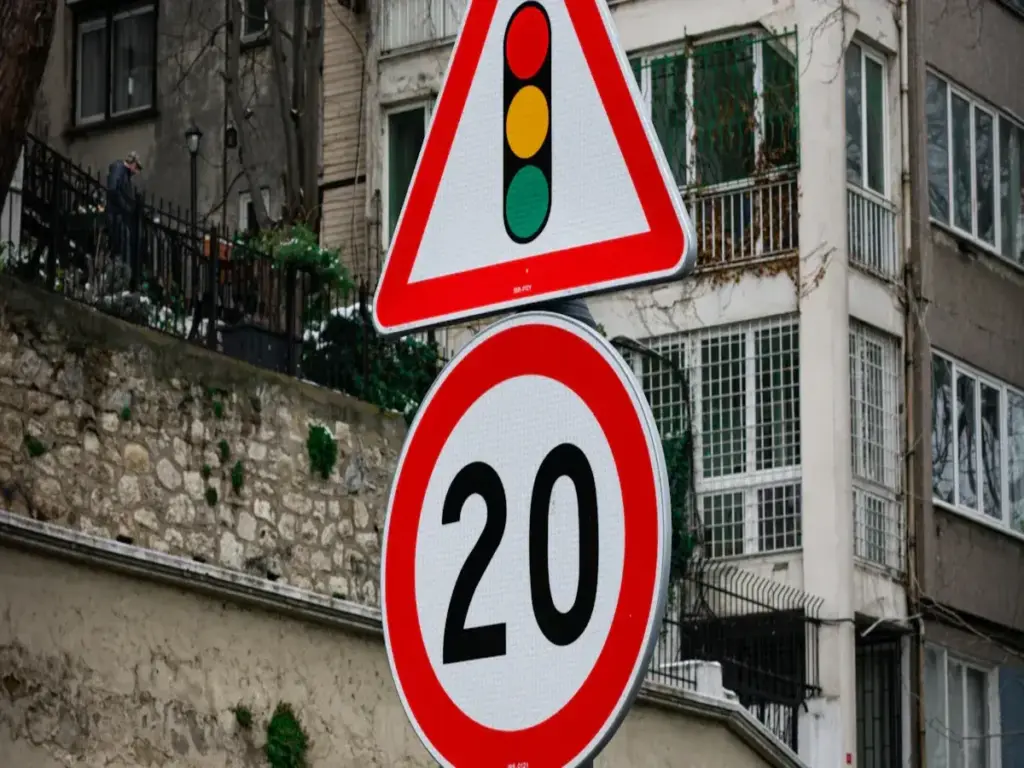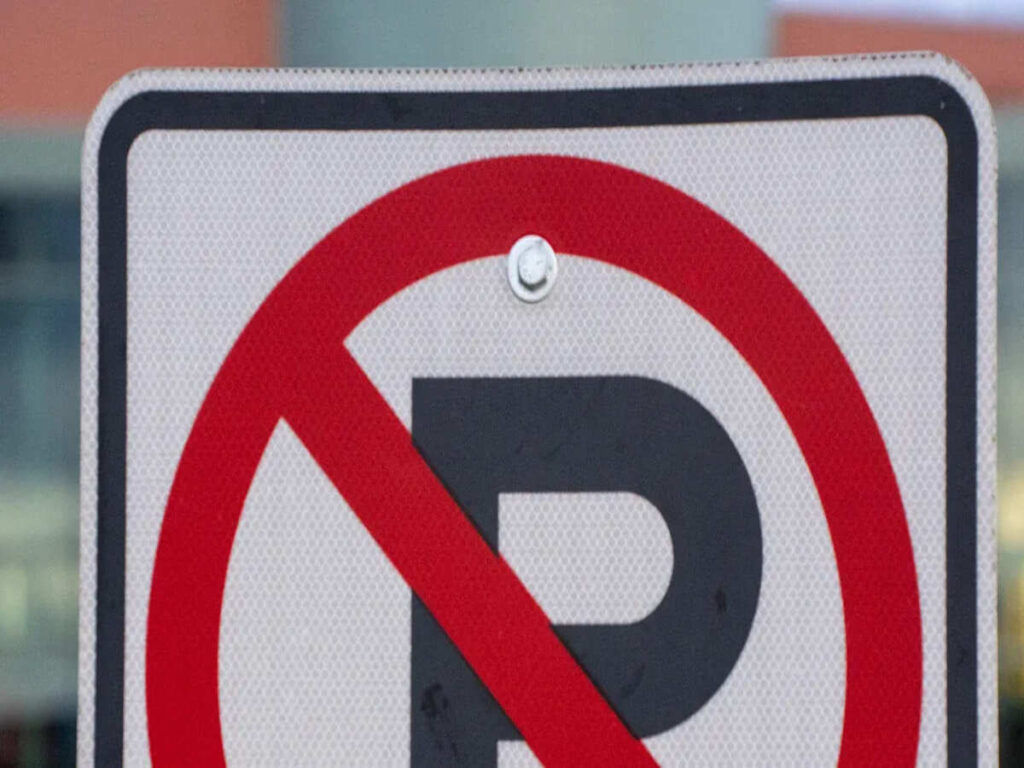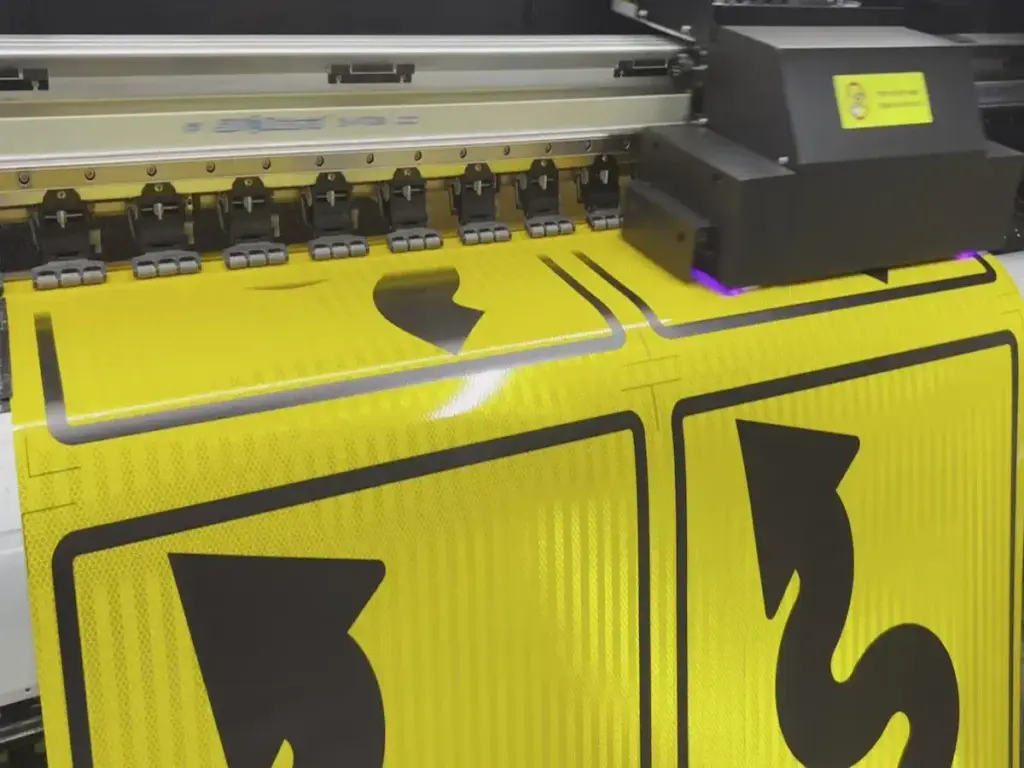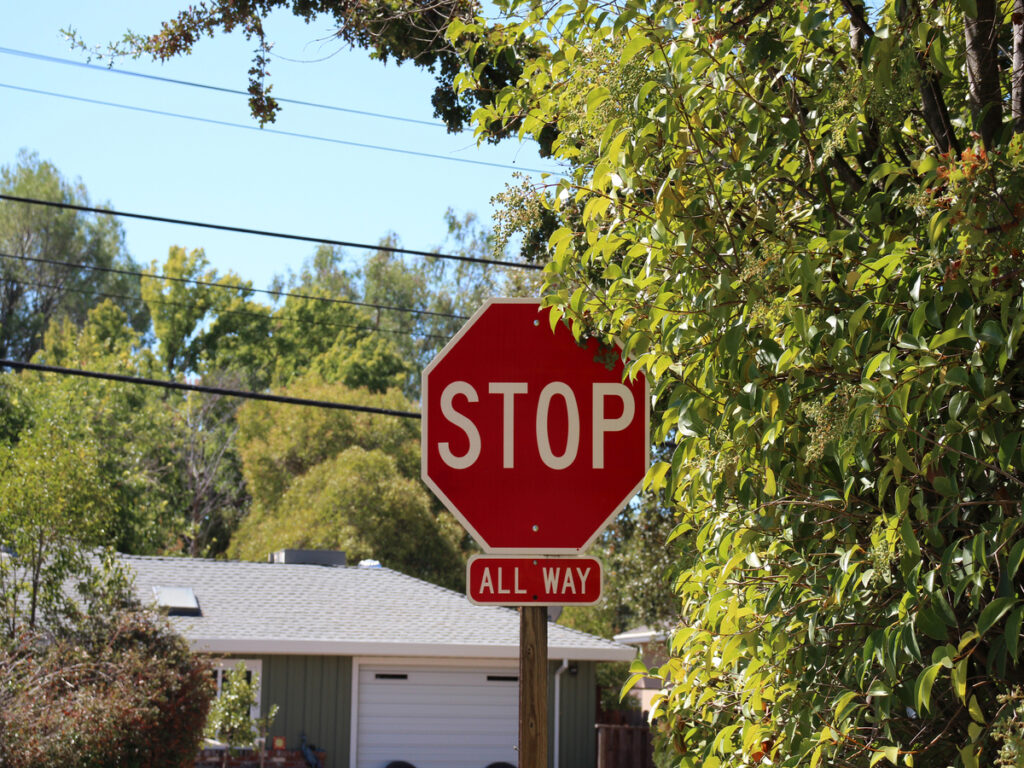
You need clear Señales de tráfico Mutcd to stay safe while driving. Legibility lets you read traffic information fast. This helps you react quickly in important moments. Research shows good MUTCD traffic signs with the right layout and visibility help drivers feel less tired and worried. Esto hace que la carretera sea más segura para todos. New technology keeps making traffic sign visibility better. Look at the table below to see how sign design changes reaction times and safety:
| Study Aspect | Hallazgos clave |
|---|---|
| Comportamiento del conductor | Good mutcd traffic signs and markings help drivers stay alert and control speed |
| Driver Visual Cognition | Clear legibility makes it easier to notice signs and think less hard |
| Driving Performance | Simple sign layouts help drivers react faster and make roads safer |
Control de llave
- Use MUTCD-approved fonts and letter sizes. This helps people read signs from far away. It also helps drivers react fast.
- Pick high color contrast and clear symbols for signs. This makes signs easier to see and understand. It works in all lighting and weather.
- Put signs at the right height, ángulo, and distance. This depends on how fast cars go and the road type. It helps drivers see signs early and clearly.
- Usa brillante, reflective materials and LED technology. This keeps signs easy to see day and night. It works even when the weather is bad.
- Controlar, limpio, and upgrade signs often. This keeps signs bright and easy to read. It helps keep roads safe for everyone.
Señales de tráfico MUTCD: Pautas
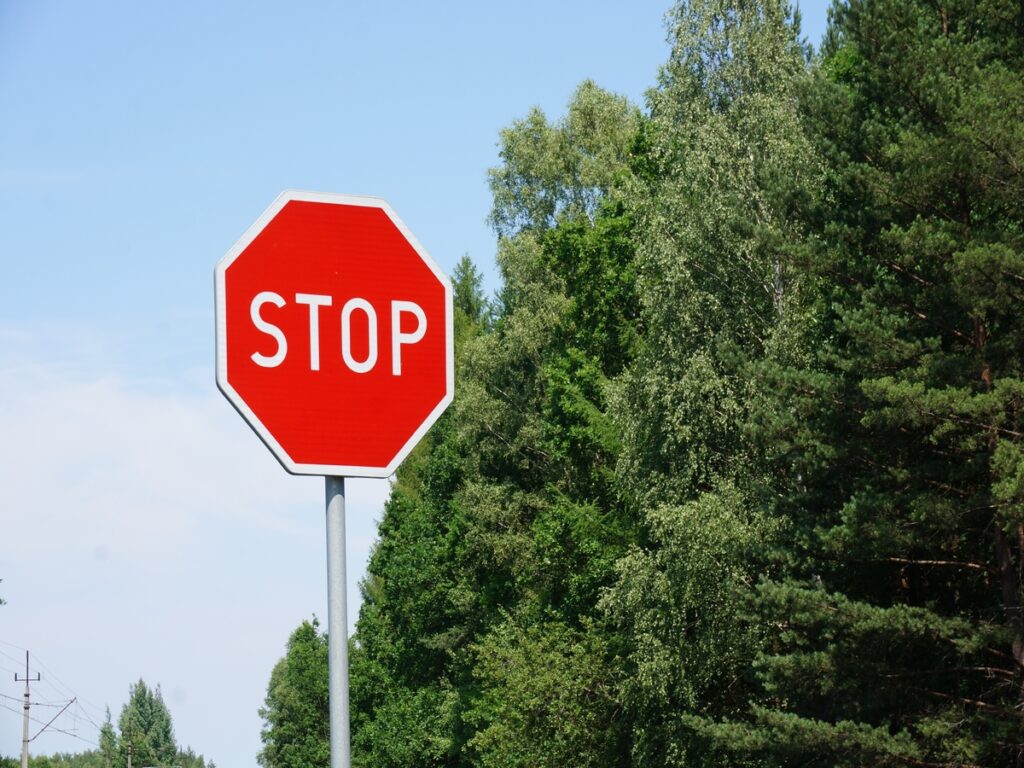
Font and Text Size
When you look at MUTCD traffic signs, you see clear letters. The MUTCD says to use FHWA Standard Alphabets for all regulatory and warning signs. These alphabets have six letter series: B, do, D, mi, mi(modificado), and F. Each series has letters with different widths and thicknesses. For freeway and expressway guide signs, Serie E(modificado) se utiliza. The MUTCD does not allow other fonts unless there is a special reason. Sans serif fonts make signs easier to read, Incluso cuando conduces rápido.
Letter size is important for legibility. The MUTCD gives a simple rule: use one inch of letter height for every ten feet of viewing distance. This helps you read signs from far away, Especialmente en carreteras. The table below shows how letter height changes how far away you can read a sign:
| Altura de la letra (pulgadas) | Maximum Impact Distance (pies) | Maximum Viewing Distance (pies) |
|---|---|---|
| 4 | 40 | 100 |
| 10 | 100 | 250 |
| 16 | 160 | 360 |
| 22 | 220 | 500 |
| 33 | 330 | 750 |
| 43 | 430 | 1000 |
| 57 | 570 | 1320 |
Bigger letters mean you can read the sign from farther away. This is important for drivers who need to react quickly. The MUTCD also says to use good spacing between letters and words. Good spacing makes each word stand out and helps you understand the message fast. Studies show yellow text works best in foggy weather, and a word spacing of 0.3 times the letter height gives the best readability.
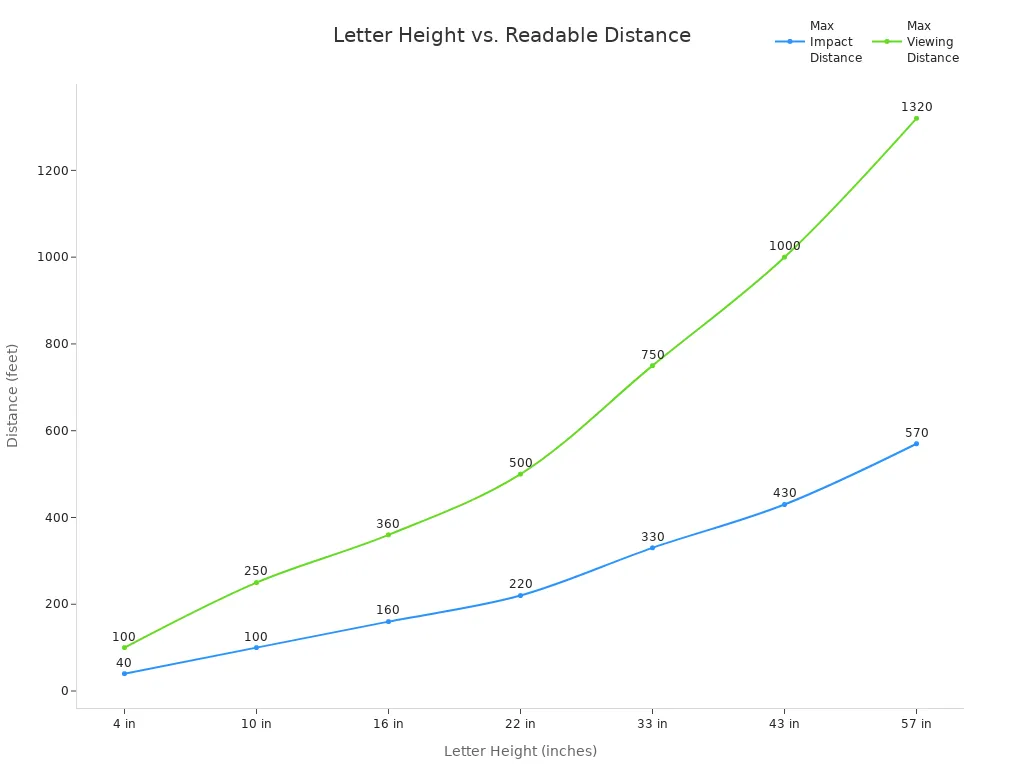
Consejo: Always pick mutcd-compliant fonts and sizes to meet fhwa compliant standards and make signs easier to see and read.
Contraste de color
Color contrast is very important for seeing and reading mutcd traffic signs. The MUTCD says there must be high contrast between the legend and the background. Por ejemplo, street name signs use white letters on green, azul, or brown backgrounds. Regulatory signs use black letters on white backgrounds. All legends and borders must be retroreflective or lit up. This keeps signs visible during the day and at night.
The MUTCD also has rules for which colors you can use. You cannot use red, naranja, amarillo, purple, or fluorescent colors for community wayfinding guide signs. These colors are saved for other types of traffic signs so drivers do not get confused. The guidelines say there must be a luminance ratio of at least 3:1 between the legend and background for community wayfinding guide signs. This makes sure there is enough contrast to see the message clearly.
High color contrast helps you notice signs quickly, incluso con mala iluminación. Rojo, amarillo, and green stand out because of their special wavelengths. These colors help you spot signs fast and avoid mistakes. Por la noche, your eyes are more sensitive to blue light. Signs with high color temperature lighting and reflective materials are easier to see and help you react faster. The MUTCD says to use anti-glare optics and reflective backplates to make signs easier to see in all conditions.
Nota: Using mutcd-compliant color contrast options keeps signs consistent and follows national standards.
Símbolos vs. Texto
Symbols on mutcd traffic signs help you understand messages fast. The MUTCD says to use symbols because you can see them from farther away than text. Symbols work well when you are driving fast or feel stressed. They also help people who do not speak English or are visiting from other countries.
- Symbols on mutcd traffic signs can be seen from farther away than text of the same size, so drivers understand faster.
- Drivers need to know what the symbols mean; if they do not, it can be confusing and slow them down.
- The ROAD WORK symbol did not work as well as the text version, so not all symbols are best.
- The workers symbol needed more looks and was harder to understand, so some symbols can confuse drivers.
- En general, using familiar symbols helps drivers understand faster and keeps them from getting distracted compared to only using text.
The MUTCD puts signs into three groups: regulador, advertencia, y señales de guía. Each group uses certain shapes, bandera, and symbols so drivers know what they mean right away. Por ejemplo, a red octagon means STOP, and a downward triangle means YIELD. A red circle with a slash means something is not allowed. Text is mostly used on regulatory signs, como límites de velocidad, or when more explanation is needed. The guidelines say to use both text and symbols if a symbol alone is not clear.
Studies show that symbols help drivers react faster and make fewer mistakes. Esto hace que las carreteras sean más seguras para todos, especially for tourists and people who do not speak English. Using mutcd-compliant symbols and text keeps signs easy to see and read and makes them the same everywhere.
Recordar: Using symbols and text the same way on mutcd traffic signs helps drivers react faster and keeps roads safe.
Guidelines for Sign Placement
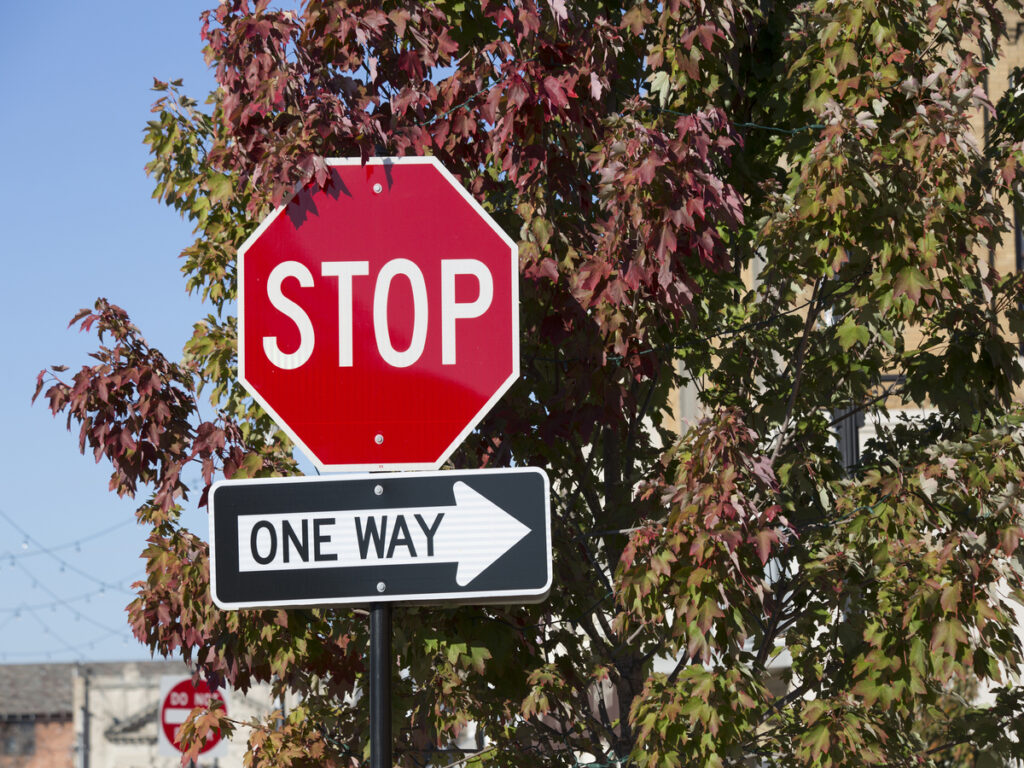
Distancia de visualización
You must see traffic signs early to stay safe. Sign placement rules focus on how far away you can read a sign. This is called sign legibility distance. How far you can read a sign changes with your speed and the road type. If you drive fast, you need bigger letters and more space between signs. En carreteras más lentas, smaller letters are okay because you have more time.
The table below shows how speed and road type change the letter size and how far away you can read the sign:
| Zona de velocidad (mph) | Recommended Letter Height (en) | Distancia de legibilidad (pie) | Notas |
|---|---|---|---|
| 30 (2-lane road) | 8 | 240 | Smaller letters for lower speeds |
| 55 (2-lane road) | 12 | 440 | Larger letters for higher speeds |
| 30 (4-lane road) | 10 | 240 | Slightly larger letters for wider roads |
| 55 (4-lane road) | 15 | 440 | Largest letters for highest speeds and width |
You can use a simple rule. Multiply the speed limit by 8 to get the best distance in feet. Por ejemplo, en 60 mph, you should see the sign from about 480 metros de distancia. This gives you enough time to react. Most people can only read three or four short words at once, so keep sign messages short.
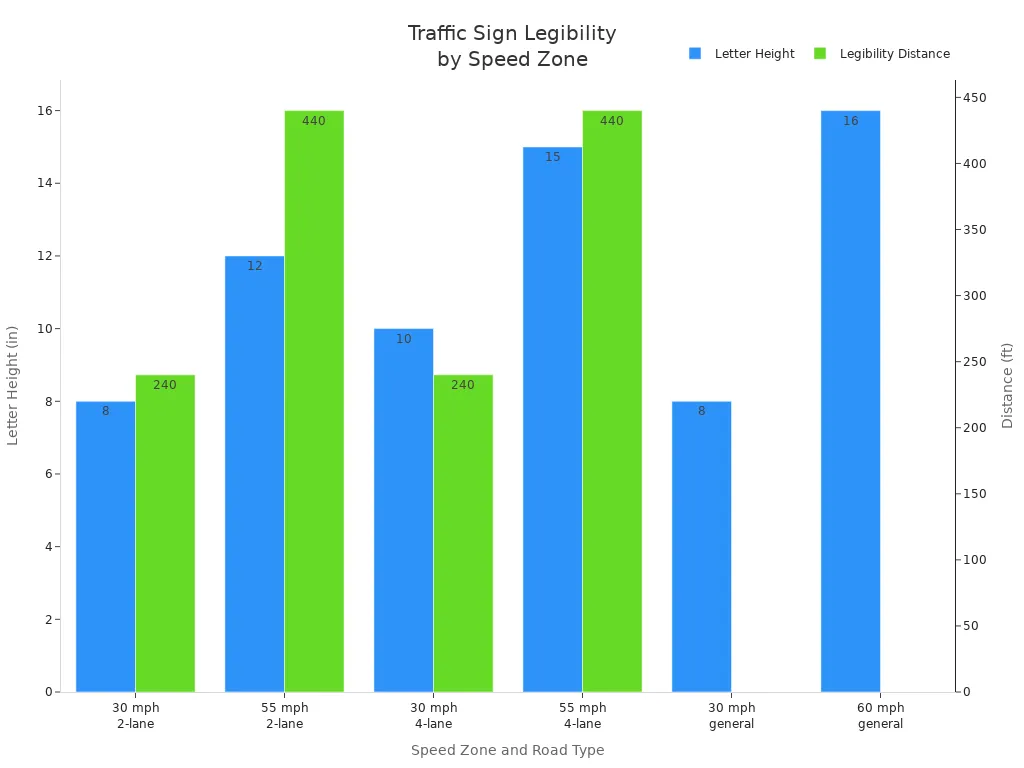
Consejo: Colocar señales donde los conductores puedan verlos desde lejos., Especialmente en carreteras. This helps people see signs early and gives more time to respond.
Angle and Height
The angle and height of a sign help people see it. The rules say to put signs high enough for drivers and walkers to see. On most roads, the MUTCD says to mount signs at least 4 pies sobre el suelo. This keeps signs above snow, autos estacionados, and other things that block them.
En las ciudades, signs are often at eye level or a little higher, generalmente entre 5 y 6 pies. This helps you see them among buildings and crowds. En el país, signs can be higher, a veces hasta 12 o incluso 20 pies. This helps you see them from far away and above trees or bumpy ground. The rules also say to set the sign at a 90-degree angle to your eyes. This cuts down glare and makes the sign easy to read.
- En las ciudades: Put signs at or just above eye level so they stand out.
- En el país: Use higher signs to avoid trees and reach drivers farther away.
- Always keep the sign at a 90-degree angle to the viewer for best visibility.
Signs on the left side of the road need bigger letters to be seen as well as those on the right. Esto ayuda a todos los conductores, no matter where they are in the lane.
Advertencia anticipada
Advance warning signs give you time to get ready for things ahead, like turns or stops. The rules say where to put these signs, based on road type and speed. Putting advance warning signs at the right spot helps you react safely and keeps things clear, even at busy places.
Here is a table showing how far apart to put advance warning signs:
| Tipo de carretera | Distance Between Signs (pie) | First Sign Placement (pie) |
|---|---|---|
| Urban low-speed roads | 100 | 4–8 × speed limit |
| Urban high-speed roads | 350 | 4–8 × speed limit |
| Carreteras rurales | 500 | 8–12 × speed limit |
| Expressways/Freeways | 1,000–2,640 | 8–12 × speed limit |
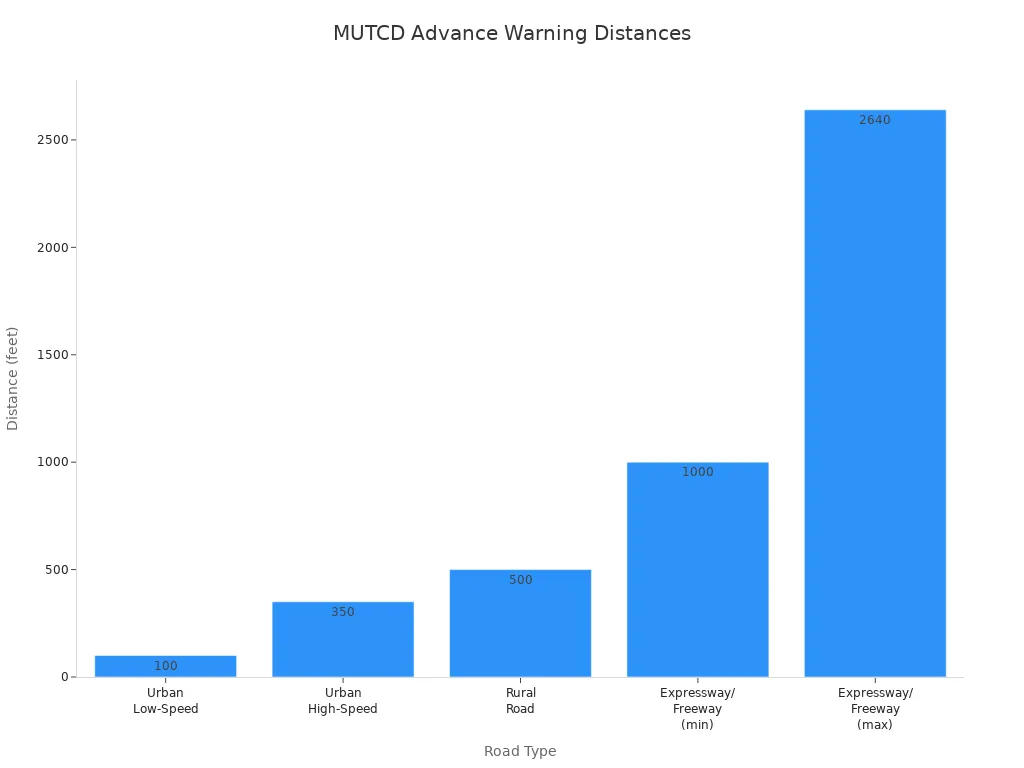
When advance warning signs are in the right place, you have time to slow down or change lanes. Studies show these signs can cut right-angle crashes by 44% and red-light running by 29%. Advance warning also helps big trucks stop safely. The rules say to keep signs neat and spaced out so you do not get confused. This makes it easier to read the sign and pick the right lane.
Nota: Putting advance warning signs in the right spot makes roads safer and helps you make better choices.
If you follow these sign placement rules, you help everyone see and read signs in time. Good sign placement keeps traffic moving safely and lets every driver react to signs, No importa dónde estén.
Factores ambientales
Lighting and Reflectivity
You can see MUTCD traffic signs best on sunny days. When the sun is behind the sign or low in the sky, signs get harder to see. Putting signs in the right spot helps stop glare. This makes sure you can read signs any time of day. Por la noche, you need retroreflective materials to see signs well. Retroreflective sheeting bounces your headlights back to you. This makes signs easy to spot in the dark.
There are different kinds of retroreflective sheeting for traffic signs:
- Grado de ingeniero is used for less important signs like parking. It is not the brightest.
- Prismático de alta intensidad (CADERA) es más brillante y dura más. It is used for many road signs.
- Grado de diamante is the brightest and strongest. It is best for highways and important warning signs.
Diamond Grade prismatic sheeting helps you see signs better at night. Prismatic lenses inside the sheeting reflect more light. This lets you see signs from farther away. The MUTCD says these materials must be very bright and last a long time. Good sign placement and strong reflective materials help you see signs in all kinds of light.
Consejo: Make sure signs are not in shadows or glare. Use Diamond Grade sheeting for the best signs at night.
Condiciones climáticas
Weather can make it hard to see traffic signs. Lluvia, niebla, and snow all make signs harder to read. Rain can blur your view and make signs look far away. Fog can hide signs until you are very close. Snow can cover signs or block roads. This makes where you put signs even more important.
To keep signs easy to read in bad weather, use bright reflective materials and extra lighting. Simple messages help you understand signs fast when you have less time. Clean and fix signs often so dirt or plants do not block them. After storms or heavy snow, check that signs are still clear.
Some places use LED or high-contrast signs in work zones or bad weather. Real-time weather tools and smart traffic lights can change sign messages and light timing. These things give you more time to react and help keep everyone safe.
Nota: Always check signs after storms. Use reflective materials so signs stay easy to see in any weather.
LED and Digital Innovations
LED Sign Benefits
More roads now use led signs. These signs have bright lights that make messages easy to see. Led signs work well during the day and at night. They help you notice warnings, Incluso en niebla o lluvia. Flashing led lights get your attention fast. You often see them at crosswalks, zonas escolares, and sharp turns. These flashing lights make signs easier to spot, especially when you need to slow down or stop.
Here is a table that compares led traffic signs and traditional signs:
| Característica | Señales de tráfico LED | Signos tradicionales |
|---|---|---|
| Visibilidad | High visibility both day and night | Limited visibility at night or in poor weather |
| Eficiencia energética | Low power consumption | Higher energy usage (if illuminated) |
| Esperanza de vida | Arriba a 100,000 horas | Vida más corta |
| Mantenimiento | Minimal maintenance needed | Frequent bulb or panel replacement |
| Impacto ambiental | Ecológico, no toxic materials | Can include hazardous materials |
Led signs last a long time and use less energy. No necesitas arreglarlos a menudo. Led warning lights and rectangular rapid-flashing beacons help drivers pay attention and keep people safe.
Un estudio de la Administración Nacional de Seguridad del Tráfico en Carreteras found that led variable message signs help drivers react faster. You can read these signs quickly, so accidents are less likely. Led signs can also change messages for different road conditions. This makes them a good choice for busy roads.
Digital and Variable Messaging
Digital signs give you updates about road conditions right away. Signos de mensaje variable (Máquinas de moda) use flashing pictures and words to warn you about traffic, clima, o obras viales. Led warning lights on these signs help you make better choices while driving.
- VMS should be placed 150 a 200 meters before a turn so you can change lanes safely.
- Pictures with flashing lights work better than just words. You see them faster and react sooner.
- Professional drivers and younger people notice these signs quickly.
- Most drivers decide what to do about 70 meters before the sign.
- Digital signs help traffic move better and stop sudden stops.
Led signs must follow MUTCD rules. You see them at least 7 pies sobre el camino. They have automatic brightness controls, so you can read them in sunlight or at night. Flashing is allowed, but not rapid flashing or scrolling. Led warning lights add to regular signs but do not replace them. Arrow boards with flashing lights help guide you in work zones and heavy traffic.
Consejo: Led and digital signs with flashing lights help you see and understand warnings right away, Hacer caminos más seguros.
Maintenance and Evaluation
Regular Inspection
You need to check traffic signs often to keep them safe. Regular checks help you find faded colors, suciedad, o daño temprano. Use different ways to inspect signs based on where they are and what kind they are. A handheld retroreflectometer measures how well a sign shines at night. Camera-based systems show how signs look on real roads, but glare or fog can make them hard to use. People can also look at signs to see if they are easy to read during the day or night.
Here is a table that explains how each inspection method works:
| Criterios | Handheld Retroreflectometer | Camera-Based Systems | Human Evaluation |
|---|---|---|---|
| Costo | Bajo | Medio | Bajo |
| Measuring Accuracy | Alto | Moderado | Low to Moderate |
| Performance in Low Light | Alto | Decreased | Alto |
| Performance in Poor Weather | Alto | Bajo | Variable |
| Data Interpretation | Low Complexity | High Complexity | Muy bajo |
| Ventajas | Accurate, objective | Captures context | Real-world view |
| Limitaciones | Only retroreflectivity | Sensitive to weather | Subjective |
It is best to use more than one inspection method. Signs made with strong retroreflective materials stay bright longer, Incluso en mal tiempo. If a sign does not meet mutcd-compliant standards, fix or replace it right away. This keeps roads safe and follows the rules.
Consejo: Checking signs often helps keep roads safe and makes sure signs are easy to see.
Cleaning and Upgrades
You need to clean traffic signs so they stay bright and easy to read. Suciedad, mugre, and plants can cover up important messages. For led signs, use a soft, damp cloth and wipe gently. Do not spray liquid on the screen. Stay away from harsh chemicals and rough pads. If a spot is hard to clean, use gentle wipes and a little cleaning solution. Always dry the sign with a soft cloth before turning it on.
For regular signs, use cleaners that do not have strong chemicals and use soft cloths. Try low-pressure washing after testing a small spot first. Clean signs right away if you see dirt or damage. Do not use too much pressure because it can hurt the shiny coating. Cleaning signs often keeps them easy to see in all weather.
Upgrading signs is important for following the rules. States need programs to replace old or broken signs. Change signs when they get old or when roads are fixed. New led signs and better retroreflective materials help you meet new standards. The MUTCD changes every four years, so check for new rules and make sure signs match. Si no sigues las reglas, you could lose money or have legal trouble.
Nota: Cleaning and upgrading signs helps drivers see them and keeps roads safe for everyone.
You help keep roads safe by following MUTCD rules for sign legibility. Clear signs let drivers make quick choices and avoid crashes. Research shows MUTCD-compliant signs slow cars down and make risky places safer. New traffic systems and better sign designs also help keep roads safe and traffic moving well. Good habits include picking strong materials, not putting too many signs together, and placing signs where drivers can see them early. When you check and improve traffic signs, you help everyone travel more safely.
- Keep traffic signs clear and easy to see for safety.
- Use your knowledge and good judgment for better traffic solutions.
- Try new technology to improve traffic and make roads safer.
Preguntas frecuentes
What is the Legibility of a MUTCD Sign?
Muescato (Manual en dispositivos de control de tráfico uniformes) signs are designed for maximum legibility to ensure safety and clarity on the road. Legibility is influenced by factors such as font size, color contrast, and the use of retroreflective materials, which help the sign remain visible at night. The MUTCD guidelines specify precise standards to ensure that signs are readable from a distance and under various lighting conditions, making them essential for effective traffic management.
What font should you use for MUTCD traffic signs?
You should use FHWA Standard Alphabets like Highway Gothic or Clearview. These fonts help you read signs quickly and clearly. The MUTCD does not allow other fonts unless you have special approval.
How often should you inspect traffic signs?
You should check signs at least once a year. Busca el desvanecimiento, suciedad, o daño. Use tools like retroreflectometers for night checks. Clean or replace signs that do not meet MUTCD standards.
Why is color contrast important on traffic signs?
Color contrast helps you see and read signs fast. Alto contraste, like white on green or black on yellow, stands out in all lighting. This keeps you safe and helps you react quickly.
What makes LED traffic signs better than traditional signs?
LED signs shine brighter and last longer. You can see them in bad weather and at night. They use less energy and need less maintenance than regular signs.


